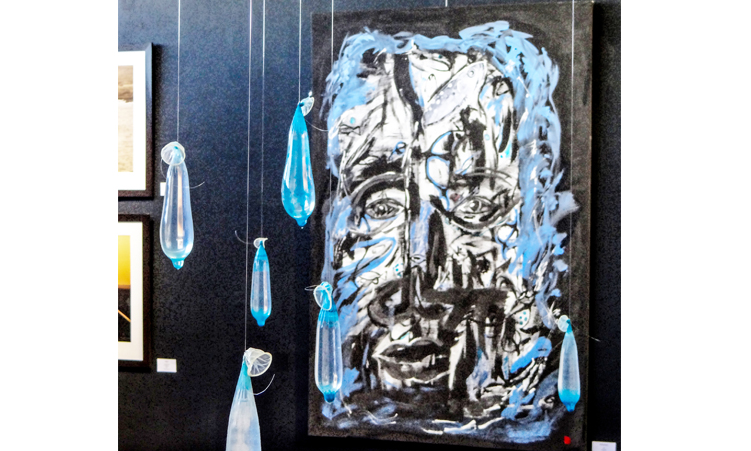Rain callers drum below darkening clouds, artists go in search of ‘The Moneyfish’ and aliens invade once pristine oceans in ‘the fish that sees its water is getting shallow cannot be stranded’.
Borrowing its title from a popular African proverb and curated by Nashilongweshipwe Mushaandja, the Owela Live Arts Collective Trust group exhibition currently on display at The Project Room contemplates a nation’s fascination.
“I used to work at an arts centre for three years and in every exhibition we did, every collection we worked with, there was fish,” says Mushaandja. “I began wondering, what is this obsession with fish? Of course, we have to be obsessed about fish. Who doesn’t like fish?”
Certainly not the artists who have peppered Namibian art history with images of fish as installations, prints, photographs, paintings, performance, mixed media and sculpture dating back to at least the early 90s.
This recurrence is what inspired Mushaandja to begin a gathering and analysis of the phenomenon of fish in Namibian art, exploring a dynamic lexicon that cuts across time, location and culture.
“The fish led me to the water,” says Mushaandja of the ongoing project and curation. “The minute you start following the fish, you realise that Namibian artists are also obsessed about something else and that’s water and rivers and so forth.”
At the offering at The Project Room, fish exist as symbols, metaphors, allegory, spirit guides and a means to survive.
In a photo series documenting a performative mobile installation in 1999, artist Kay Cowley recalls ‘In Search of the Moneyfish’ in which a cast of fish seek out a wish-granting fish but find the process of dream-dissemination to be mired in bureaucracy and corruption.
Retrospectively linked to the Fishrot scandal of today, Cowley’s presentation additionally converses with Peter Mwahalukange’s tongue-in-cheek linocut print depicting a giant fish coming back to bite an even larger politician.
Beyond the fish and diving deep into the water, artists Shomwatala Shivute, Jo Rogge and Julia Hango (JuliArt) reflect contemporary crises. Photographing the effects of efundja in northern Namibia, marking the oceanic migrant crises through mixed media and identifying humans as the aliens invading and polluting aquatic landscapes in a central installation, respectively, the artists position various bodies of water as sites of catastrophic climate change, perilous exodus and man-made environmental disaster.
Navigating ideas of water and memory, artists Tuli Mekondjo and Veronique Kuchekena-Chirau each find themselves at Lüderitz and on Shark Island. Significant for its local fishing industry, but also as a site of genocide, forced labour and a concentration camp during the German colonial era, Lüderitz inspires both artists to don traditional attire while reckoning with the traumatic histories of the space and the sea.
Set to the sounds of various songs of Yemayá, the Yoruba orisha of motherhood and the ocean, the exhibition also includes Hango’s altar to the goddess where patrons are invited to breathe and feel cleansed.
Framing water as a place of birth and return, a source of healing and a landscape in need of protection from human greed, extractive capitalism and pollution, Hango creates new work on water that is expansive in its exploration, mimicking the artist’s rendering of the dynamic river and streams of one’s psyche.
The exhibition additionally features work by Samuel Mbingilo, Hercules Viljoen, Ismael Shivute, Elia Shiwoohamba and Barbara Böhlke as well as images of Gift Uzera, Muningandu Hoveka, Joanne Sitler and Diolini’s multidisciplinary Owela Festival performance titled ‘Water’.
As for the fish that sees its water getting shallow, Mushaandja likens the creature to the average Namibian who witnesses their natural resources, most famously fish, being mismanaged and exploited yet finds alternative ways to survive.
“Apart from it speaking to survival and resilience, it has to do with wisdom. Preparing for the future and preparing for the worst which I think is what we often find ourselves in as Namibians,” says Mushaandja.
“We know we have issues but there is always somewhere where there is water.”
– [email protected]; Martha Mukaiwa on Twitter
and Instagram; marthamukaiwa.com




Leave a Reply